Empowering Women
The Nike campaign I will be discussing launched in 2005 around the same time Dove was
featuring "real women" in their advertisements. Some may read that Nike
was portraying similar "real women" but though intertextuality I will
show that this was not their aim. Intertextuality is "the way the
meaning of any one discursive image or text depends not on that one text
or image but also the meanings carried by other images or texts" (Rose
142). So by cross reading several of their advertisements using
discourse analysis one I aim to show that Nike is creating a similar
unachievable idea of what a woman should look like that is shown in high
fashion magazines. Discourse "is a particular knowledge about the world
which shapes how the world is understood and how things are done in it"
(Rose 142). Although high fashion's and Nike's ideals differ they both
create a woman that isn't "normal" but one that is beautiful and should
be a role model. This page will mostly focus on three images from the Nike
campaign along with the assumption that high fashion images of women are
recognized as beautiful and therefore an ideal for other women to show
that Nike is not portraying a real woman but rather an alternative
equally unattainable womanly figure.
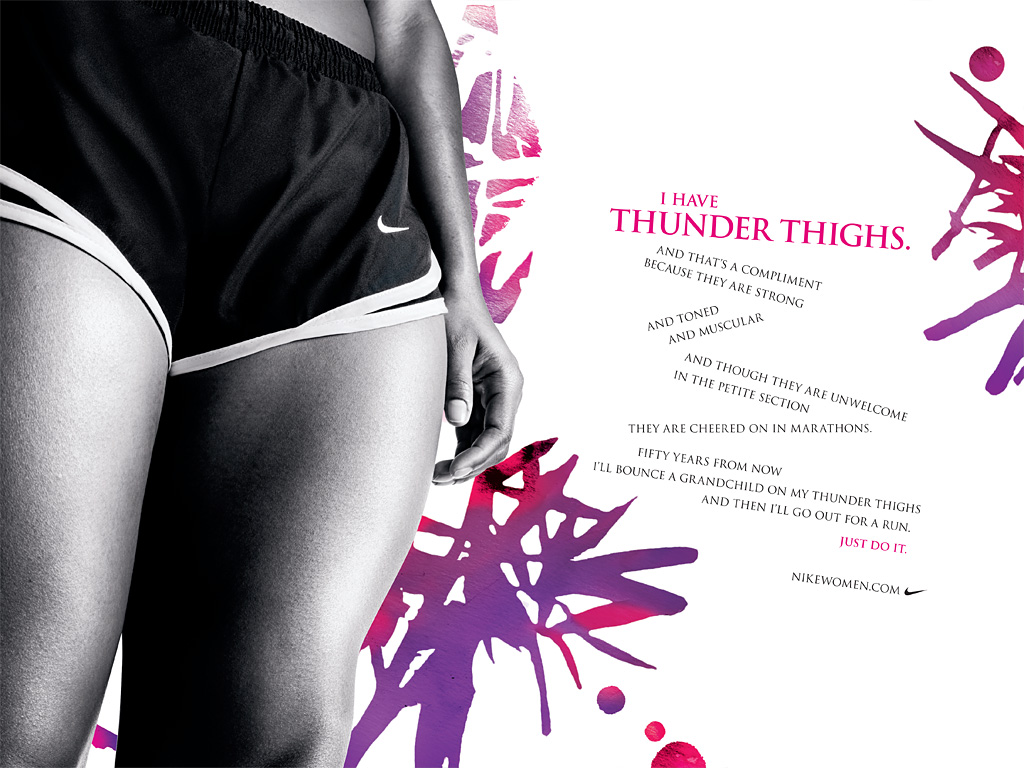 |
I HAVE THUNDER THIGHS.
AND THAT'S A COMPLIMENT
BECAUSE THEY ARE STRONG
AND TONED
AND MUSCULAR
AND THOUGH THEY ARE UNWELCOME
IN THE PETITE SECTION
THEY ARE CHEERED ON IN MARATHONS.
FIFTY YEARS FROM NOW
I'LL BOUNCE A GRANDCHILD ON MY THUNDER THIGHS
AND THEN I'LL GO OUT FOR A RUN.
|
To begin, this ad plays off the ideology that women should not have big
thighs. Ideology, as defined by Rose is "knowledge that is constructed
in such a way as to legitimate unequal social power relations" (Rose
75). This ideology has not only been built from years of
advertisements, tabloids, and fashion magazines portraying small women
with thin legs, but also from how clothing fits. Further the thighs and
text in this ad point to the historical idea that women should not be
strong but rather petite. This points to the presumption and underlying
gender norms in our culture. Women are supposed to be feminine which is
everything masculine is not, and strength is a "masculine" attribute.
When pointing out their size the ad is omitting fat, hair, and
cellulite, common "problems," with big thighs. By showing pure perfect
strength, the ad doesn't allow for any imperfections. Similarly fashion
magazines don't allow for the same imperfections of fat deposits and
cellulite. This ad is simply replacing a current skinny petite woman
with an athletic one with similar standards of perfection. Although
these thighs may show a more realistic woman, they are neither an easily
attainable goal nor a common sight, even among women who participate in
athletics. At this time I should clarify that I am making assumptions
from an athlete's point of view, having participated in soccer for over
17 years now, I feel well qualified to do so.
MY BUTT IS BIG
AND ROUND LIKE THE LETTER C
AND THE THOUSAND LUNGES
HAVE MADE IT ROUNDER
BUT NOT SMALLER
AND THAT'S JUST FINE.
IT'S A SPACE HEATER
FOR MY SIDE OF THE BED.
IT'S MY AMBASSADOR
TO THOSE WHO WALK BEHIND ME
IT'S A BORDER COLLIE
THAT HERDS SKINNY WOMEN
AWAY FROM THE BEST DEALS
AT CLOTHING SALES.
MY BUTT IS BIG
AND THAT'S JUST FINE
AND THOSE WHO MIGHT SCORN IT
ARE INVITED TO KISS IT.
|
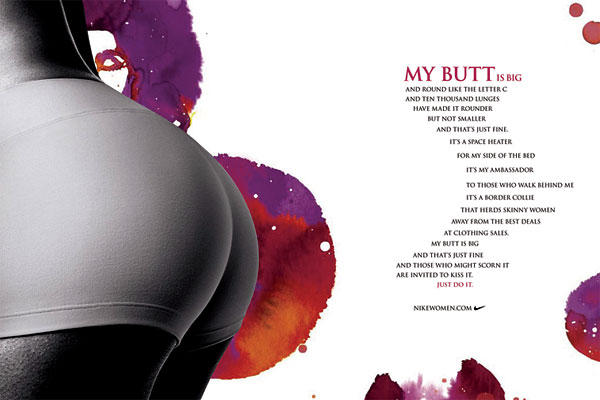 |
Like the thighs ad, this ad doesn't allow for imperfections. The butt
shown is smooth and perfectly round, not saggy or fatty. The
differences between strength and tone are a key part to this
advertisement and draws a clear line that "BIG" does not translate to
"FAT." Also, it mentions the skinny women of the world and implies that
this body shape is better than the petite. It also presumes that women
should be strong and have that drive for athletic perfection. She shows
that the athletic butt is in direct competition to the skinny butt when
describing clothing deals, which I find interesting because skinny women
clothes won't fit the athletic body type. I believe it is omitted to
show the direct competition of the athletic butt over the skinny. This
competition can also be related to athletic drive that a woman with this
butt has to have, to be the best, the most fit, the most athletic, the
biggest butt.
The butt advertisement also implies that a big butt is a sexually
desirable object, when it refers to "my side of the bed." She has
someone to share her bed with because she has a perfect rear-end. This
sexually desirable trait emphasizes Nike's overall message that
perfection of the athletic shape should be envied by all women that
cannot achieve the end goal of a perfect behind.
By inviting "those whomight scorn" her big butt to "kiss it" she is not
only showing a physical strength but a mental strength as well. It
shows confidence like the last one and makes strength simultaneous with
beauty and confidence. Yet, this perfect strength and beauty isn't for
everyone and isn't attainable for anyone. It takes a certain type of
woman to have the motivation to do "ten thousand lunges" and not every
woman can be this.
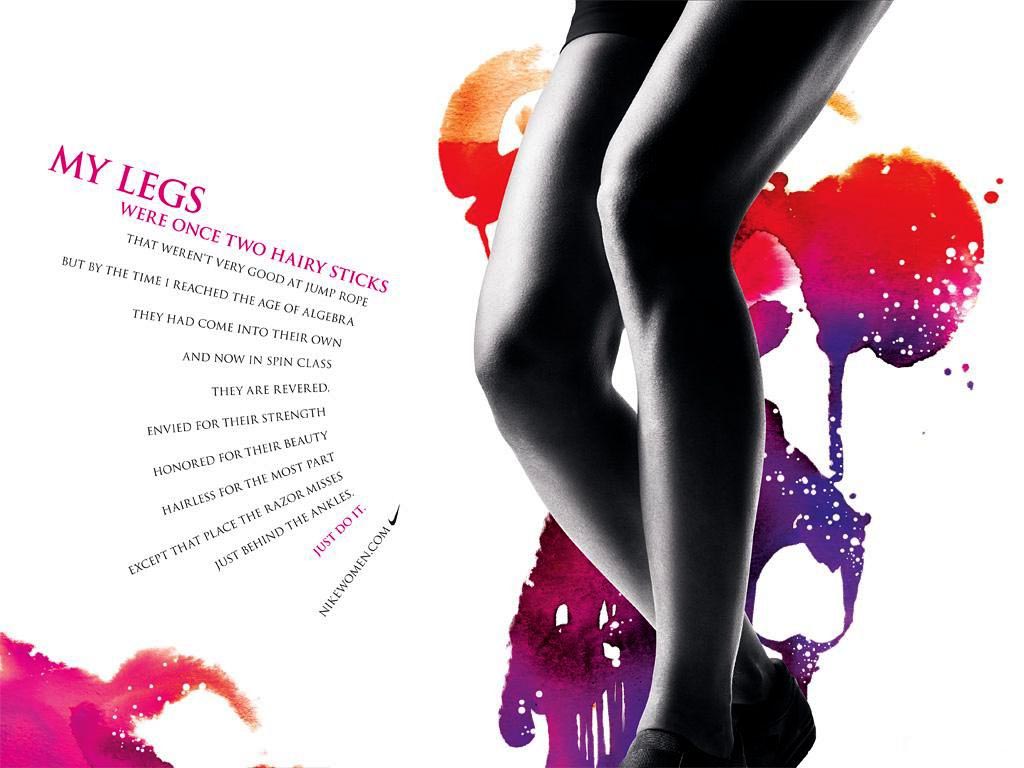 |
MY LEGS WERE ONCE TWO HAIRY STICKS
THAT WEREN'T VERY GOOD AT JUMP ROPE
BUT BY THE TIME I REACHED THE AGE OF ALGEBRA
THEY HAD COME INTO THEIR OWN
AND NOW IN SPIN CLASS
THEY ARE REVERED.
ENVIED FOR THEIR STRENGHT
HONORED FOR THEIR BEAUTY
HAIRLESS FOR THE MOST PART
EXCEPT THAT PLACE THE RAZOR MISSES
JUST BEHIND THE ANKLES.
|
Clearly the importance of beauty is emphasized in this ad. The words
"revered" and "honored" also point to the desire that has been hinted at
in the previous two ads. Along with the butt ad the hard, unattainable,
work is shown in the text. The ad points that her legs have not always
been perfect but that they required work and time.
Although this ad is mostly about perfection it does hint to the tiny
imperfection of a missed shaved spot behind the ankles, presumably
because her calves are too big for her to see that spot. This spot is
important also because it is unseen in the advertisement, which gives
the impression that perhaps the athlete pictured is simply being modest
for the first time throughout the ads. It also points to a small
insecurity that the woman has. This insecurity is can also be
attributed to a feminine trait because most women are presumed to be
insecure about something physical. This insecurity is the only one
through the ads that is mentioned and is significant because it relates
to other women just like shopping (in the butt ad) and having
grandchildren (in the thighs ad).
Finally, the overall lack of clothing in these advertisements points the
audience to a feeling of desire not to necessarily wear Nike, but to buy
into the idea that athletic bodies should be idolized more than skinny
bodies. Without showing product alone, one can conclude that Nike isn't
necessarily selling their brand but a feeling that goes along with the
brand. They are aiming to sell their readers a feeling so that when the
goal becomes these body parts Nike can help. The connection to the
everyday women mentioned briefly in each ad also makes that goal seem
more attainable however unattainable it may actually be.
|
Stanley Wearden and Pamela Creedon argue that the first WNBA games aired
on television in 1997 "showed women succeeding at a high level without
the stereotypical dependence on conventional beauty or sexuality"
(Wearden, 192). During his study of the commercials during the 1997
WNBA games, they found that either women in these ads were
stereotypically put down or they were empowered with very little ground.
As I've touched on before, Nike is known for their "inspiring"
advertisements that are aimed at "empowering" women. From my reading of
"'We Go Next,'" I think that Wearden and Creedon would agree with me,
yet Nike also has put out this line of advertisements for their shoes. |
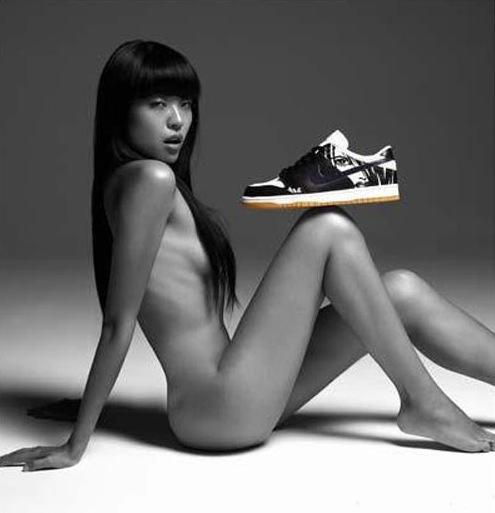 |
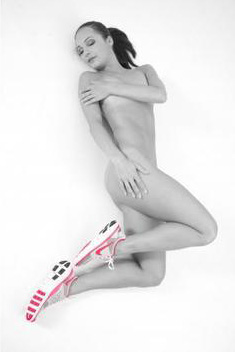 |
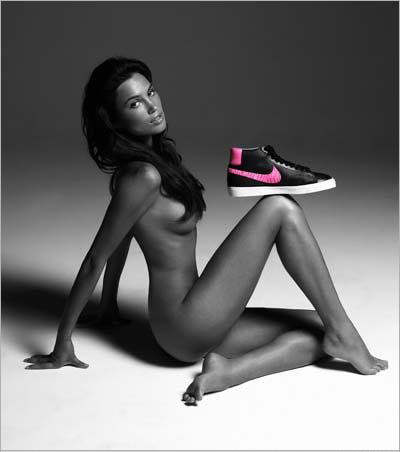 |
-back- -next-
Works Cited
Rose, Gillian. Visual Methodologies: an Introduction to the
Interpretation of Visual Materials. London: SAGE Publications, 2007.
Wearden, Stanley T,; Creedon, Pamela J.."'We Got Next': Images of
Women is Television Commercials during the Inaugural WNBA Season."
Culture, Sport, Society. 5.3 (2002). 189-211. Web.
Images (click)
Thighs
Butt
Legs
3 Shoe Ads





